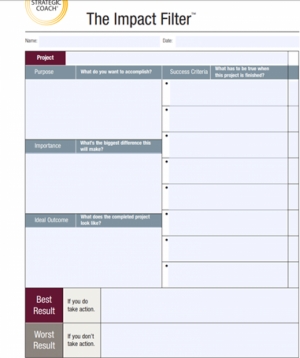عرض العناصر حسب علامة : الاستراتيجية
الأحد, 12 سبتمبر 2021 13:00
أفضل استراتيجيات إدارة العملاء لشركات المحاسبة
كثيرًا ما نلاحظ أن مالكي شركات المحاسبة يهتمون كثيرًا بعملائهم. ومع ذلك، يعتقد العديد من الأفراد الذين يغيرون شركاتهم أنهم لم يتلقوا الرعاية المناسبة من محاسبهم السابق.
معلومات إضافية
-
المحتوى بالإنجليزية
Better client management strategies for accounting firms
By Jason Schow and Jason Blumer
March 09, 2021, 11:35 a.m. EST
6 Min Read
Facebook
Twitter
LinkedIn
Email
Show more sharing options
We frequently observe that accounting firm owners care a lot for their clients. Still, many individuals who change firms believe they didn’t receive the appropriate care from their previous accountant. There is a clear disconnect regarding the accounting professional’s intent.
This is a phenomenon that we directly experience with some new clients. They typically tell us that their last firm wasn’t proactive enough and didn’t provide the value they expected. Yet from interactions with hundreds of accounting professionals, we have seen firsthand that they generally care very much for the people they work with.
So how can the accounting profession provide clients with a high-value service that reflects the firm’s concern? The answer may be in the creation of an efficient client management strategy — an aspect that is often not given the proper attention as firms grow.
Managing Your Firm in a Post-COVID World
Think beyond the pandemic with exclusive resources to help you build a thriving virtual practice.
SPONSORED BY INTUIT ACCOUNTANTS
Client management is an essential aspect of leading and running a professional accounting firm efficiently and providing ongoing value to clients. Also, as your clients are the firm’s source of revenue, they are obviously central to your company’s sustainability and growth.
It is a good idea to manage each clients’ entire journey versus expecting them to decide how, when, and what they purchase from the firm.
A client management strategy has a model that each firm can follow to make sure they are providing the client care needed to keep their firm running and developing. Overlooking this ecosystem can impact resources and result in clients receiving a lower level of service.
There are three stages where client management is particularly important: onboarding, pricing, and more generally in your business model.
Client onboarding
This is the first step when you start working with a new client before they receive any services. Something that has stood out as good practice during this phase is to make sure the clients you take on are a good fit for the way you do business. This is key to building a sustainable firm that you and your staff enjoy.
The process of new client intake can be slowed down to a point where you can create a place for value judgments, where both you and the potential clients can decide to work together or not. When the sales process is slowed down like this, you can give comfort to the client while increasing the perceived value of your work.
Some aspects — or the entire process — can be virtualized, for example by using Zoom conferences and shared documents. It is now possible to operate a virtual firm, and with the current pandemic situation, it is even an encouraged practice.
The ultimate goal in the client-onboarding phase should be to align with the potential client, dive into real discovery of their needs, and prepare them to be priced.
Pricing
Pricing is the second phase and happens before the service begins. Determining value in pricing is generally a skill that takes time and practice to master. Here are some questions we suggest asking potential new clients to help define price:
Why are you looking for a new accountant? Why now?
What do you hope to achieve in working with our firm? What do you see in us that made you interested?
How will we know this is successful?
What has stopped your company from resolving this in the past? What might stop your company from achieving these results in the future?
What will your company look like in two years?
What keeps you up at night?
What gets you up in the morning?
What have you valued about past relationships with financial coaches or advisors?
If working with our firm requires more time from you, can you commit that time? What are you willing to say no to for our collaboration to be a success?
What are all the issues to be addressed?
Did we get it right? What did we not ask that we should have?
Here are some practical observations on different types of pricing:
Hourly billing lends itself to a faster, more commodity-based firm business model. Hourly billing takes no client assessment, no conversations as to what the client may value, and puts the client in control to let the firm know what to do. Hourly billing is the fastest form of running a firm, as it takes little time to bring new clients into the firm. Any client is welcome in a billing firm.
Fixed pricing applies a single price to a service that is offered by the firm. Note that this is different from value pricing, where only the client has a price. Firms that offer monthly packages are doing fixed pricing.
Value billing is another form of hourly billing, yet takes it one step further. When the bill is calculated, a value markup is applied if the client perceives higher value than when the services were started. This is a difficult model to operate within since the influence of value with a client begins at the outset of a relationship, not after the work has been completed.
Value pricing is the slowest form of a firm’s business model. In a value-pricing firm, there are essentially no prices for services. Only the clients have prices since all services can (and are) sold to them for different prices depending on what they value most.
Firms do not have to exclusively adopt one model of pricing or billing but can instead weigh their benefits and apply the different models to different client groups or to different divisions of a firm (in large organizations). For example, firms offering advisory services would lend themselves to value pricing done by the owners of the firm, while the accounting and tax recurring revenue of many firms is suitable for a fixed pricing model.
No matter which model of pricing is chosen in your client management strategy, value is the core component to help the client and firm align on the goals and payment of the service.
Business model
The business model is the final phase where service happens and is the team structure you use to deliver services.
The way you manage your company’s capacity is fundamental to your firm being able to create efficient profit. There are several pillars to capacity management:
Time and location: These are the more controllable aspects of capacity. A firm can request their team work a certain amount of time in locations that afford the greatest productivity and use of that capacity.
Mind and emotions: These elements are generally not controllable. These are simply what the humans working in the firm bring with them each day. They are not strategic at all, and you never know when issues may appear and prevent the professional from focusing on their work. Leaders of the firm should be able to identify any team inefficiencies if they want to create profit for their growth, investment, and distributions. Managing and strategically predicting capacity is the key to turning the right amount of revenue into efficient profit.
Project management: This is the management of the scope of your services, the assignment of work to the team members, and the management of related software products that this management resides in. Project management is the foundation of service and is how a firm owner knows what work is flowing through their firm and what is being managed properly.
This is a high-level overview of the client management journey, and we hope it helps as you navigate this topic. Client management is an important matter in any firm. Without a strong vision about what this means, both firm owners and clients will struggle. Tackling topics like client management sets a firm apart to provide immense value, which in turn justifies higher prices in the marketplace they serve.
نشر في
موضوعات متنوعة
موسومة تحت
الثلاثاء, 22 يونيو 2021 11:54
كيف تساعد الرؤية والاستراتيجية الشركات الصغيرة على النجاح
تبدأ العديد من الشركات حياتها بفكرة رائعة ولكنها تكافح لكي تصل الى العالمية ولذلك نقدم لك المكونات الرئيسية التي تستطيع ان تبني منظمة قوية داخلياً وخارجياً.
نشر في
موضوعات متنوعة
موسومة تحت
الثلاثاء, 29 يونيو 2021 09:15
بعض أدوات جوجل المجانية التي تساعد العملاء في العثور على شركتك
معلومات إضافية
-
المحتوى بالإنجليزية
These free Google tools will help potential clients find your firm
By Lee Frederiksen
March 12, 2021, 1:12 p.m. EST
In today’s digital world, you can’t make an impact — or remain relevant — if your audience can’t find you. As Google continues to raise the bar for digital marketers and webmasters attempting to uncover the best search terms to attract traffic to their websites, their ability to find the right keywords to draw audiences to their websites has become key to maintaining a pipeline.
Google has made this job all the more difficult by denying access to organic search terms — a change the search engine giant reportedly made to protect individuals’ privacy. Whatever the reason, the result has been a reduction of as much as 90 percent of keyword data available for research. Much of that data is now being represented as “not provided.” Instead of having the luxury of seeing every keyword that drove traffic to their websites, organizations looking to optimize their digital content must now get creative to determine what keywords will work for their online strategies.
Simply stuffing content full of keywords is not a productive optimization strategy either.
Managing Your Firm in a Post-COVID World
Think beyond the pandemic with exclusive resources to help you build a thriving virtual practice.
SPONSORED BY INTUIT ACCOUNTANTS
Search engines, in general, have become a lot smarter. By processing large numbers of queries over time, their algorithms have gotten better at determining searcher intent behind keywords, in particular,whya user is searching. They can then present the most appropriate results, not just offer up “exact-match” search results that may or may not be satisfactory.
Given the rising necessity of proper keywords to achieving greater search engine visibility and the growing number of hurdles to figuring out what keywords will work best to help achieve online marketing goals, any digital marketer worth their salt must be familiar with the tools of the trade. Fortunately, some of the most indispensable tools happen to be free. Let’s take a look at the six best free tools to help you identify the most appropriate keywords for optimizing your content:
Google Auto-Populate: This is the best place to start your keyword research because it reveals what searchers are thinking when they start typing their query. Auto-Populate works by anticipating what searchers are looking for when they start typing and filling in long-tail search terms for them, which searchers often use instead of finishing their own typing. This not only provides clues to popular long-tail search terms but reveals the kind of content that already exists around your topic of interest. Who better to give you suggestions about keyword opportunities than Google?
Google Related Searches: This is another tool that should be at the top of your list when starting your keyword research. Similar to Auto-Populate, this function provides “related searches” at the bottom of most search engine results pages (SERPs). It too reveals popular search terms that Google has already identified and can help you expand your research parameters through word associations.
Google Ads Keyword Planner: This is a good place to start focusing your search for a new keyword. Typing in a prospective keyword will yield data on the average monthly searches for that term, the competition, and a suggested bid price for it, as well as alternative suggested keywords and phrases. You don’t need to be considering a paid campaign to use this function — it’s helpful by showing you alternative keywords you might want to consider and the average monthly searches for the keywords you’re interested in.
Google Search Console: This is the tool for hardcore webmasters and SEO professionals. It reveals the top queries being searched as well as the top web pages returned through search. Search Console will show you both the top queries and the content that has driven the most traffic to your site over the same time period.
Google Trends: Once you’ve established interest in a particular search term, this tool will help you choose the optimal variation of it. You can also use it to compare and analyze the popularity of several variations of your search term over time and even view a forecast for certain terms.
Google Analytics: Just because a large chunk of organic search data is now labeled as “not provided” doesn’t mean Google Analytics can’t be helpful. There is a section under “Acquisition” that contains your Search Console data if you have linked up both platforms. If you look under “Search Console – Queries” you’ll find information similar to what’s in Search Console.
Although it’s become harder to determine what keywords and search terms will work best for your website and other online content, it’s still vital that you do so. It’s also important to remember that all the best keywords in the world won’t help if your content is not useful, valuable and shareable. If the right content is there, visitors will come, and the right keywords will help them find it.
نشر في
موضوعات متنوعة
موسومة تحت
الثلاثاء, 24 مايو 2022 07:15
إنفوجرافيك.. أربعة أخطاء شائعة يجب تجنبها عند اختيار إدارة الشركاء
نشر في
إنفوجرافيك
موسومة تحت
الإثنين, 22 فبراير 2021 12:20
تنمية ممارستك -بدون إضافة عملاء جدد
ليس سرا أن المنافسة اليوم شرسة. أضف ذلك إلى عام الوباء حيث كانت العديد من الشركات تكافح من أجل البقاء
معلومات إضافية
-
المحتوى بالإنجليزية
Growing your practice — without adding new clients
By Charles Hylan
February 17, 2021, 9:00 a.m. EST
3 Min Read
Facebook
Twitter
LinkedIn
Email
Show more sharing options
It’s no secret that competition today is fierce. Add that to the year of the pandemic where many businesses were struggling to survive, and the thought of growth may seem like a stretch goal. However, it was and is possible. And the best part is that you can likely grow your practice without adding new clients. A few simple steps and modifications or additions to your current business model can make all the difference.
1. Benchmark your firm with others your size and in your market. One of the first things you can do is to benchmark your firm with other firms in your space. The easiest way to accomplish this is to determine your financial and managerial metrics and compare them to similar firms in similar-sized markets. Although you may have to purchase comparisons for a small fee, there are numerous comparison metrics available for a multitude of categories. Examples of just a few reference metrics include income per partner, overall billing rate, administration as a percent of total headcount, staff-to-partner ratios, average annual billable hours per partner and per staff, professional staff turnover, and many more.
Benchmarking will allow you to make comparisons and determine where you lag behind industry norms. You can then develop an action plan to address and improve your performance in those areas.
2. Form strategic alliances to strengthen your firm’s service offerings. Another area to consider when growing your firm with your current clientele is to form strategic alliances with trusted firms and companies offering complementary services. For example, law firms that specialize in trusts or financial services firms are “low-hanging fruit” — obvious choices for partnering. Further, depending upon your clientele and their industries, you may want to partner with specialty tax, financial or engineering firms geared toward your client’s industry.
Two key takeaways when considering strategic alliances are to keep an open mind, and to thoroughly evaluate both your clients’ needs and the quality of the alliances with whom you partner. Forming optimal strategic alliances can allow you to better serve your clients, position your firm as the center of expertise, and increase firm profits per client.
3. Become a thought leader for your niche. While your offerings may be diverse, concentrating your efforts on a particular niche or specialized offering will lead your clients to start recognizing you as an expert or thought leader. Sharing your knowledge and expertise freely through multiple outlets including web forums, blog posts, FAQs on your website, social media posts, and publications will keep your name associated with specialized areas and information. Reaching your existing clientele with thought leadership content will keep them engaged and loyal by viewing you as a trusted advisor.
4. Manage your customer relationships and build loyalty. At the end of the day, it’s the people-to-people relationships that build firms, not marketing plans or campaigns. A vital piece of increasing revenue from your existing clients is to manage their experience and build loyalty. To effectively and efficiently accomplish this, there are multiple customer relationship management software packages available that can help. When choosing a CRM that’s right for your firm, a critical eye should evaluate it for its applicability, ease of use, and versatility. While there are many CRMs on the market, there are some built specifically for accounting firms.
A CRM software should help you efficiently and strategically manage marketing, sales, and client relationships. Your CRM system should not only assist you with managing these relationships, but it should also help identify the relationships that matter the most and offer a personalized experience.
5. Upsell your existing clients. The strategies above will provide a framework for upselling your existing clients with additional or more comprehensive services. With a CRM system supporting timely communication and thought leadership content that positions you as an expert in your field, your clients will organically inquire about related services and offerings that could benefit them and their business. You want to be the “go-to” firm for your clients’ financial lives, and you can lean on the strategic partnerships described above to fulfill any gaps in your existing services.
When looking to grow your business this year, the strategies above provide a powerful opportunity for you to do so without having to add additional clientele. By enriching the relationship, you are creating loyalty and growing your practice with your existing client base — it’s a win-win for your firm and your clients.
نشر في
موضوعات متنوعة
موسومة تحت
الأربعاء, 21 سبتمبر 2022 12:17
استراتيجية جيدة أم استراتيجية سيئة أم عدم وجود استراتيجية على الإطلاق؟
كان جاك ويلش، رئيس شركة جنرال إلكتريك الأسطوري، يحب أن يقول، "إن الخطوة الأولى لجعل إستراتيجية حقيقية هي الاكتشاف"
معلومات إضافية
-
المحتوى بالإنجليزية
2021: Good strategy, bad strategy or no strategy at all?
By Kyle Walters
January 12, 2021, 11:12 a.m. EST
4 Min Read
Facebook
Twitter
LinkedIn
Email
Show more sharing options
Legendary GE chairman Jack Welch liked to say, “The first step to making a strategy real is figuring out the big ‘Aha!’ that gives you sustainable competitive advantage.” Following that logic, Welch said: “If you don’t have a sustainable competitive advantage, then don’t [try to] compete.”
I know what you’re thinking: “Our firm is doing well, but I don’t know if we really have a sustainable competitive advantage.” Actually, you do have a competitive advantage: It’s called your relationship with your clients. And if you’re thinking to yourself: “Geez, now I have to develop a strategy on top of getting through busy season,” that’s actually a good thing. It puts you ahead of most of your peers.
I’ve found that many highly motivated people confuse goals with strategy. There’s a big difference. There’s a great book by Richard Rumelt called Good Strategy, Bad Strategy. Rumelt believes there are three key elements at the core of every good strategy:
1. The diagnosis;
2. The guiding policy;
3. The coherent actions.
Managing Your Firm in a Post-COVID World
Think beyond the pandemic with exclusive resources to help you build a thriving virtual practice.
SPONSORED BY INTUIT ACCOUNTANTS
Rumelt calls those three elements the “kernel” of a strategy. Let’s take them one at a time.
Step 1: The diagnosis. Like most people, many CPAs have a hard time simplifying all the complexity in their lives. It could be figuring out how to bring in great people to their firms, or improving their systems and processes. or getting better at marketing. Well, you can’t solve tough problems unless you diagnose them properly.
Charles Kettering, the iconic former head of research for General Motors liked to say, “A problem well stated is [already] half solved.” Using an "Impact Filter", which I discuss later in this article, can be a great, simple tool for helping you ask the right questions.
Step 2: The guiding policy. After diagnosing the problem, the next step is figuring out how you are going to deal with it. What’s your overall approach? What’s your big-picture plan? January is when most people, full of hope, talk about all the things they’re going to accomplish in the year ahead. Unfortunately, just talking about what you’re going to do is not going to move the ball down the field. Instead, you must be very intentional about how you plan to use your firm’s resources.
You only have so many resources — time, money and people — to go around. A truly coherent strategy forces you to pull resources toward areas of higher expected return and away from areas of lower expected return. You can’t allocate all your resources to every single initiative on your list. If you do, you’ll find yourself spread too thin and not making progress on anything.
Sound familiar?
Step 3: The coherent actions. According to Rumelt, these are the clear steps that need to be coordinated to carry out your guiding policy (see Step 2 above). In other words, identify what needs to be done, by whom and by when to implement your strategy.
Famed Silicon Valley venture capitalist Peter Thiel believes that with the right strategy in place, you can reach your 10-year goals in just six months. You don’t have to be a high-flying tech firm or a pharma company developing a COVID vaccine to accomplish this. You just need to determine the areas of your business that you need to be accelerated ASAP — and then allocate the necessary resources to support those areas.
What I learned the hard way
When I started my firm, I was full of boundless energy. I thought I had really solid 10-year goals and enough energy to tackle every opportunity that came my way. I learned over time that I did not have a coherent strategy. I did not have a kernel, as Rumelt would say. I simply had aspirations such as growing 10 percent each year, making three great new hires a year, or providing best-in-class client service.
Great ambitions, but I wasn’t thinking carefully about how many additional resources I’d need to deploy to reach those goals. I wasn’t thinking about where I’d have to sacrifice resources from other areas.
Resources and techniques to help you prioritize
One of the best ways to formulate a well-asked question is to use a simple Impact Filter. It’s a simple one-page form developed by Dan Sullivan, a.k.a. The Strategic Coach. The filter forces you to crystallize your thinking about an idea or initiative and helps you arrive quickly at a tangible go/no-go decision. If nothing else, the Impact Filter will prevent you from meandering and wasting precious time and resources.
90 Day Rocks, pioneered by EOS Software, are great for prioritizing your goals and resources — and for measuring your progress as you pursue them. Write down the top five things you could accomplish at your firm over the next 90 days:
1. Having a better client onboarding process;
2. Building a better client portal/vault;
3. Implementing a better CRM;
4. Just making April less stressful;
5. Improve your staff’s continuing education program.
Now pick one of those items above — just one — and cross off the other four. Be 100-percent committed to doing the one thing you selected. Make sure everyone at your firm is onboard with that decision, too.
Often the hardest part about developing a new habit is just getting started. Once you do, you’ll become a bona fide Anti-Fragile CPA before you know it — a trusted advisor who adapts well to change and who always helps clients and team members make better decisions.
Talk about a competitive advantage!
نشر في
موضوعات متنوعة
موسومة تحت
الثلاثاء, 09 فبراير 2021 11:43
30 دقيقة من وقتك يمكن أن توفر لك 30 يومًا من العمل
معلومات إضافية
-
المحتوى بالإنجليزية
30 minutes of your time could save you 30 days of work
By Kyle Walters
June 11, 2019, 3:58 p.m. EDT
5 Min Read
Facebook
Twitter
LinkedIn
Email
Show more sharing options
How many times has an excited colleague burst into your office requesting a meeting to discuss a great new idea they have? How many times have you had your own ideas for a new project or initiative that could be a bona fide game-changer for your firm?
And how many times have those great ideas come to fruition? Not many, right?
Most of the time people start working on something exciting without knowing where they are going or why they are doing it. Inevitably they run out of time, energy and support from colleagues. Sound familiar?
Managing Your Firm in a Post-COVID World
Think beyond the pandemic with exclusive resources to help you build a thriving virtual practice.
SPONSORED BY INTUIT ACCOUNTANTS
In the old days, firms would assign someone — usually the champion of the idea or an outside consultant — to write a business plan or to conduct a feasibility study of the idea before moving forward. But, in today’s fast-paced world, the window of opportunity might close (or a competitor might have already moved in) by the time the business plan or feasibility study is completed. Fortunately, there is something called an Impact Filter that can rapidly crystallize your thinking about an idea or initiative and quickly arrive at a go or no-go decision.
Source: The Strategic Coach, Inc.
The Impact Filter, developed by renowned entrepreneur coach Dan Sullivan, may look like a simple one-page grid on the surface. Trust me; it’s not simple at all. One thing I really like about filling out an Impact Filter is that it prevents you from meandering. It forces you to “filter out” all the noise and distractions in your day-to-day life so you can focus 100 percent on your idea or opportunity. You have no choice but to stop and think carefully about what success really looks like before you start working on a new project or initiative. Isn’t that a lot better than the alternative — just winging it — or even worse, “analysis paralysis”?
If you, or someone on your team, is not willing to fill out an Impact Filter before starting a project, that’s a pretty good “acid test” that the project is not worth doing. Spending half an hour defining what success looks like on a project will really help you understand it and make you better able to communicate your vision of a successful project or initiative to others at your firm. That type of communication is essential for building support and commitment.
How CPA firms can use Impact Filters
Sure, filling out an Impact Filter will be a little more work on the front end, but it will save you tons of time, effort and confusion on the back end. That’s why Dan Sullivan’s company, Strategic Coach, Inc. uses the mantra, “30 minutes saves you 30 days.”
The Impact Filter has a wide variety of uses. It can be used to evaluate the merits of a new website your firm is considering. It could be used to assess the viability of a new client onboarding process you’re considering, a new hiring plan or marketing plan, new tax software or a new branch office.
Let’s take a new marketing plan. Instead of just saying, “We need to post more on social media,” the Impact Filter helps you answer big questions such as:
What are you trying to accomplish?
What does it look like when it’s completed?
Or suppose your firm is deciding whether or not to open a new branch office. The Impact Filter will help you decide why you really want to expand, what you’re really trying to signal strength to the marketplace (i.e., “we’re growing fast and we’re prosperous”), and whether or not you really need a more convenient location for the staff.
If the answers you come up with are not compelling, you might realize you shouldn’t be spending time, effort and money expanding the office after all.
At our firm, everyone from partner to administrative assistant is required to fill out the Impact Filter before taking on a new project. In fact, we won’t hold a meeting to discuss a new project until an Impact Filter has been completed. More often than not, the person with the great idea will answer their own questions about the project’s feasibility just by completing an Impact Filter — the team meeting to discuss the merits of the idea often becomes unnecessary.
Guardrails, not brakes
Impact Filters were originally developed for entrepreneurs and business owners — notoriously scattered creatures who are certainly not CPAs. Most entrepreneurs are so busy working in the business they don’t have time to work on the business. They typically have a host of unfinished projects, or the projects have been completed, but haven’t been implemented. Think of the Impact Filter as a tool for getting organized around projects. Again, the Impact Filter is not for higher-ups at an organization to shoot down a project. It’s for getting the champion and the project crystal clear on what success looks like.
Let’s say your firm does a quarterly planning meeting. What are these big hairy projects that always come up? Do an Impact Filter for each one. It will help you understand which ones will be most valuable for your organization, or more importantly, which ones are most valuable but need more time to be unpacked?
Thirty minutes will save you 30 days, but don’t get hung up on the 30-minute rule
Half an hour might be pretty aggressive for completing an Impact Filter thoroughly, especially for new users. I generally set aside an hour, sometimes two hours, to complete it. The key is to let your brain decompress first and make sure you can carve out some undistracted deep-thinking time. No phone calls, no email, no social media.
Filling out an Impact Filter will get easier each time you do it. The reason it’s so hard for many people at first is because they’re not used to thinking. That’s right. We don’t spend much time actually thinking during the workday. We spend the majority of the day reacting — putting out fires and racing to meetings and deadlines. Thinking and reacting are very different things.
Don’t be a perfectionist
As CPAs, we tend to be highly detailed people accustomed to rigid rules, best practices and deadlines. The Impact Filter is an iterative, ongoing exercise that has to keep evolving. That’s a big mindshift for many CPAs. But I can tell you for certain, if you commit an hour of uninterrupted thinking to the Impact Filter, it will be a lot better than anything else you had before. You can always make adjustments. Just get started and get your next project documented and on the right track.
Give the Impact Filter a try. Feel free to send it over to me for a complimentary assessment. After reviewing your Impact Filter, I’ll give you three follow-up questions to think about.
نشر في
موضوعات متنوعة
موسومة تحت
الثلاثاء, 26 يناير 2021 12:08
هل الانكار نهر في مصر أم هو حالة مؤسستك؟
معلومات إضافية
-
المحتوى بالإنجليزية
Is denial a river in Egypt or the state of your firm?
By Dom Esposito
We all know that denial is not a river in Egypt, but how many of us know that denial is the state of our firm?
In his 2008 book entitled “Strategy and the Fat Smoker,” David Maister wrote that we often (or even usually) know what we should be doing in both our personal and professional life. We also know why we should be doing it and (often) how to do it. Figuring all that out is not too difficult. What is very difficult is actually doing what you know to be good for you in the long run, despite short-run temptations. Therefore, many leaders, and by extension many small and midsized CPA firms, live in denial.
More often than not, what needs to be done by a firm’s managing partner or CEO is obvious. While it’s not always easy, he or she needs to make those tough decisions in the best interests of the firm. But many leaders are in denial and fall short of what’s required, and, in many cases, that’s the principal reason why so many firms can’t get to the next level or, worse yet, can’t perpetuate themselves.
Managing Your Firm in a Post-COVID World
Think beyond the pandemic with exclusive resources to help you build a thriving virtual practice.
SPONSORED BY INTUIT ACCOUNTANTS
Presented below are the obvious but not easy things that a managing partner needs to do in today’s world of public accounting to be viewed as an effective leader who sits on top of a firm that is not in denial:
Walk and talk the vision, mission and strategy of the firm. Lead by example. “Do as I do, not as I say.”
Create an environment that breeds trust, persistency and consistency.
Shepherd senior partners and potential all-stars.
Create a firm-first (our clients vs. my clients) culture.
Be open to service diversification. Move away from the traditional accounting firm model to a professional services firm model.
Address ineffective partners on a timely basis.
Realize that size (with quality and profits) matters, and explore a business combination or two if that is in the long-term best interests of clients, staff and partners.
Deliver on the client promise of being a trusted advisor.
Create goal setting, accountability and discipline — first and foremost with the partners and then with the staff.
Drive industry specialization, the undisputed vehicle to provide client distinctiveness and value.
Implement a partner compensation plan that is fair and equitable, incentivizes high performers and potential all-stars, and avoids “sprinkles.”
Get value from non-billable time.
Create a balanced approach to partner and staff utilization that’s neither too lenient nor too overbearing.
Insist that a strategic plan may require a “no” when an idea doesn’t conform.
Develop an effective “farm system” for talent, particularly future partners.
Avoid being too many things to too many sectors.
Gain market permission from the gatekeepers such as investment bankers, attorneys and bankers who will enable you to move upstream with clients.
Grow for strategic purposes not simply for volume.
Require the proper mix of clients, marquee clients (credential builders) and other clients that help pay the rent and train the staff.
Have corporate governance and operating models that work for the overall firm.
Always have the desire (and ability) to invest in the future.
Help partners and staff realize that quality work doesn’t necessarily mean quality service.
From a quick review of the above, it’s clear that a managing partner is the heart and soul of a CPA firm, the one who must do what needs to be done to avoid denial and to ensure success. Having said that, many firms do not have effective managing partners. Here are four common mistakes to avoid when selecting managing partners:
1. Don’t ask the firm’s No. 1 biller to be managing partner.
While a successful managing partner usually carries a small client load to stay grounded in client service and to remain credible with the partner group, billings and chargeable hours are truly a small part of the job. In my view, a managing partner’s clients are the partners, giving them the opportunity to maximize their strengths while minimizing their weaknesses. A managing partner has to be readily available for big opportunities or problems.
2. Think long and hard before you ask someone from the outside to be managing partner.
Without a lot of due diligence and partner buy-in, an “outsider” is too risky, particularly if someone comes from outside the professional services firm environment. An outsider obviously doesn’t know the firm’s history or culture or the partners’ individual strengths and weaknesses. An outsider also isn’t attached to the firm’s vision, mission and strategy. Please stay away.
3. Don’t ask two partners to function as co-managing partners.
In the spirit of political correctness, it’s not unusual for firms to select co-managing partners. It’s a safe decision that doesn’t offend quality partners who compete for the position.
While from time to time, this kind of arrangement can work, many times it doesn’t and is therefore a step that should be taken with lots of caution. Too often firms with co-managing partners are plagued with inaction or conflicting directions with little, if any, consistency on strategy. If co-managing partners can be avoided, take the bold step and the tough decision: select the right person for the job today and make sure you do your best to retain the other contenders.
4. Don’t ask a part-time committee to be managing partner.
Firms can’t operate by part-time committees. A firm needs to make decisions and move on. Sure, a firm needs oversight committees such as a management committee or an operations committee to drive their day-to-day activities. A firm also needs an executive committee for corporate governance, partner matters and strategy. But a firm can’t easily do what is obvious if the key leadership role is delegated to a part-time committee that reacts to situations if and when time permits. It’s a recipe for disaster. No one is thinking about strategy and the future while, at the same time, making sure that the necessary blocking and tackling are being tended to.
So, why do some firms continue to live in denial and lack an effective managing partner? In many cases, it comes down to trust and security.
Many firms select a new managing partner from their ranks at an age somewhere between 45 and 53. Candidates are usually excellent client relationship partners with substantial client service responsibilities. The thought of giving up a substantial portion, if not all, of the client relationships that have been developed over years of service is scary to many. For sure, there is a risk in being a managing partner. Candidates may ask, “What happens if I’m not successful? In the spirit of trust, I lose most, if not all, of my client responsibilities and begin to lose touch with my outside referral sources. I’ll have nowhere to go but to exit the firm when I’m no longer the managing partner.”
This is a very real concern and many firms do not want to recognize the severity of the issue. Instead, firms say, “trust us,” and while that’s easy to say, history has shown that this trust has sometimes been misplaced. As a result, for the overall good and welfare of a firm, I recommend that a managing partner be offered an agreement that addresses what happens if he or she is no longer the leader of the firm. Such an agreement can address what happens to future compensation, what happens to employment, and what happens to retirement benefits or deferred compensation arrangements. It can pay huge dividends down the road for everyone.
نشر في
موضوعات متنوعة
موسومة تحت
الأحد, 10 يناير 2021 12:17
هل حوكمة شركتك ونماذج تشغيلها فعالة؟
تحتاج شركات المحاسبة الصغيرة والمتوسطة التي تسعى جاهدة للبقاء مستقلة إلى تجنب "الفخاخ " المحتملة التي يمكن أن تعيق نموها وتهدد استقلاليتها في النهاية
معلومات إضافية
-
المحتوى بالإنجليزية
Are your firm’s governance and operating models effective?
By Dom Esposito
Small and midsized CPA firms that are striving to stay independent need to avoid the potential “sand traps” that can stump their growth and eventually threaten their independence.
Regardless of your firm’s size, it’s absolutely essential that you avoid ineffective governance and operating models that will get in the way of achieving growth at an acceptable rate of 6 to 8 percent per year (which is easier said than done organically) and staying independent. If you land in this sand trap, your firm will eventually stagnate and ultimately die or have to merge up with a larger firm.
Today, more often than not, larger firms (and those that aspire to be larger firms) look to one partner group to govern (usually referred to as an executive board, partner board or executive committee) and a second group of partners (the senior operating leadership team) to drive strategy and to oversee day-to-day operations. To be most effective, these two groups need to complement each other. In many firms with highly regarded brands, these two groups comprise different partners to foster healthy checks and balances within the firm.
Unfortunately, all too often, at many of the small and midsized firms, these two groups and their responsibilities are vested with just a single governance and operating committee appointed by the CEO or managing partner. While it’s easy to fall into this trap, this isn’t a healthy way to run a firm. Sometimes it creates a mentality of us versus them. It also creates a good old boys club that becomes inbred. This unhealthy environment often results in favoritism (which is terrible for morale), hampers revenue growth (which is terrible for the partners’ wallets), and makes it difficult to nurture future leaders (which threatens the viability of a firm).
So, let’s take a look at a model for effective governance and operations:
Executive board
Effective governance at any size firm can be achieved by an executive board comprising both senior partners and more junior, high-potential partners — perhaps five to nine in total, depending on the size and complexity of your firm. Generally, the CEO or managing partner is an appointed member, and other members are elected by the partners at large to rotating three-year terms with a limit of two years. The executive board usually meets one day a month (twice when it gets close to compensation time). In the interim, between face-to-face meetings, the executive board holds a video conference or conference call to discuss matters that can’t wait for the next regularly scheduled meeting. The responsibilities of the executive board usually include: (a) approving the firm’s strategic plan and holding the CEO and other firm leaders accountable for the plan’s implementation, (b) approving mergers, acquisitions or a firm name change, and (c) overseeing the successful resolution of partner matters (such as compensation, lateral hires outplacements and new internal admissions).
Senior operating leadership team
Depending on the size of your firm, effective day-to-day operations are best accomplished through a senior operating leadership team comprising the CEO, COO, regional managing partners, office managing partners, audit, tax and consulting leaders, and a go-to-market leader. Again, some of these positions may not be appropriate in your firm today because of its critical mass, number of service lines and/or number of locations. Nevertheless, regardless of size, in addition to the CEO, every firm, at a minimum, should have an office managing partner, three functional leaders (in audit, tax, and consulting or advisory services), and a go-to-market leader (many firms do not have this position today).
While all positions are important, I want to emphasize the importance of a go-to-market leader, who is typically responsible for driving industry and consulting strategies both at the operating office and individual partner levels. This partner, who generally has a small client load and a reduced number of billable hours compared to other partners, is the partner shepherd who leverages their strategic skills into others. If you don’t currently have such a partner in your firm, I highly recommend you consider one.
The senior leadership operating team usually meets one day a month, like the executive board. These meetings create subtle peer competition and promote the sharing of best practices. In between face-to-face meetings (typically held to handle an opportunity that requires quick collaboration), the operating team usually holds a video conference or a conference call. The operating team’s responsibilities usually include reviews of key management tools that enable a firm to execute success.
Trying to grow and staying independent requires a firm to avoid the many potential traps in practice management. Effective management is the key to success, but unfortunately many small and midsized CPA firms do not follow the best practices for corporate governance and operations
نشر في
موضوعات متنوعة
موسومة تحت
الأحد, 23 أغسطس 2020 13:46
دراسة ماجستير: محددات إدارة التكلفة البيئية في ظل متطلبات الإدارة الاستراتيجية
اهتمت الدراسات المحاسبية خلال الآونة الأخيرة بتطوير العديد من الأساليب الحديثة لإدارة التكلفة لدعم وزيادة القدرة التنافسية للمنشأة، إلا أن أغلب الأساليب اقتصر تطبيقها على العمليات الداخلية في المنشأة ولم تأخذ في اعتبارها العلاقات التعاونية أو البيئية التي تسود بين المنشآت والتي يمكن أن تمثل فرصاً لتخفض التكلفة وتعظيم العائد لجميع أطراف سلسلة الأعمال
نشر في
رسائل ماجستير و دكتوراة










